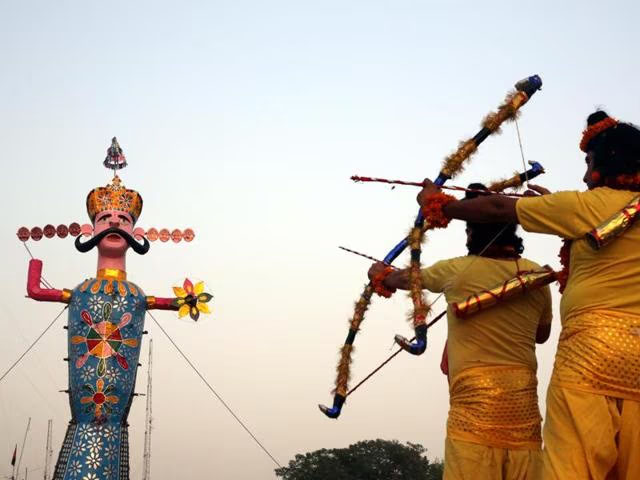Vijaydashami is when all the distortions of the mind and negative tendencies fall away. This day symbolizes victory over all cravings and aversions of the mind we had gathered through the year.
It celebrates the day when righteousness triumphed over evil, symbolizing the ultimate victory of good. Ravana’s ten heads represent ten negative qualities to be eliminated, and the burning of his effigy signifies the need to eradicate these negativities within ourselves. By shedding these negatives, our inner Divinity shines forth.
On Vijaya Dashami, we strive to remove all negativity and celebrate our inner triumph. This day reminds us of our inherent joy and purity, reminiscent of our childhood. It is a time for rejuvenating our spirit, clearing away accumulated negativities, and embracing a life of continual celebration and enlightenment.
In North India, Vijaya Dashami is marked by Ravan Dahan, which profoundly connects Devi and Shri Ramji. Ram’s return to Ayodhya symbolizes both a historical event and an internal victory. During Chaitra Navratri, we honor Shri Ramji’s birth, while Sharan Navratri celebrates His return, reflecting the divine light within us.
The Symbolism of Ram and Ayodhya
Ram represents our Atma, our inner self, while Ayodhya symbolizes our body. Ayodhya, meaning “invincible,” refers to a body that cannot harm or be harmed. This aligns with the essence of Vijaya Dashami—when the Atma, the divine consciousness, enters this invincible body, victory manifests. This internal triumph is the essence of Atma Gyan, or self-knowledge, highlighting the festival’s focus on personal triumph.
The Deeper Meaning Behind the Story of Ramayan
The story of Ramayan offers more than its surface narrative. “Ra” means light, and “Ma” means within me, so Ram signifies the light within us. Born to Dasharath and Kaushalya, Dasharath represents one with ten chariots—symbolizing the five senses and the five organs of action. Kaushalya embodies skill, Sumitra represents belonging, and Kaikeyi stands for generosity. With the blessings of the Rishis, Dasharath and his three wives welcomed Ram into the world. Ram represents the soul, the divine light within us. Lakshman signifies awareness, the ever-watchful aspect of our being. Shatrughan stands for the absence of enemies, while Bharat embodies brilliance and talent. Ayodhya, meaning “that which cannot be conquered or destroyed,” represents our body. Our body is Ayodhya, and the king of this body is Dasharath—the five senses and organs of action. When Sita, symbolizing the mind, strayed from Ram, the soul, Ravana, who represents the ego, kidnapped her. Ram and Lakshman (soul and awareness), with the help of Hanuman, who embodies life force or energy, strive to bring Sita (the mind) back home. This narrative underscores the festival’s deeper message—restoring inner harmony and celebrating the divine essence within us.
The Significance of Devi’s Victory on Vijaya Dashami: Overcoming Inner Conflicts and Revealing Divine Nature
During these 9 days of Navratri, we worship Mahakali, who vanquished the demons; Madhu and Kaitab. These demons, arising from Lord Vishnu’s ears while He rested, embody Raag (desire) and Dvesh (aversion). Their defeat by Mahakali symbolizes the overcoming of inner conflicts. This divine victory is essential for understanding Vijaya Dashami—transcending the negative forces within us to reveal our true, divine nature.
The Role of Meditation and Fasting
To awaken this divine power within us, we engage in meditation and mantra chanting. Proper fasting during this period should be done with awareness. Many consume high-starch foods like potatoes or sweets while fasting, which can hinder the purification process. Instead, fasting should focus on light, easily digestible foods like fruits and buttermilk, which enhance purification and consciousness. This practice ties directly into the festival’s purpose—preparing ourselves for deeper spiritual insight and personal growth.
By recognizing the divine light within, we align with the eternal celebration of life. This victory over inner negativity and worries brings us closer to understanding that our true essence is ever-present and luminous. The message of Vijaya Dashami is to recognize and embrace the grandeur within us, transforming every moment into a celebration of our highest self.






























